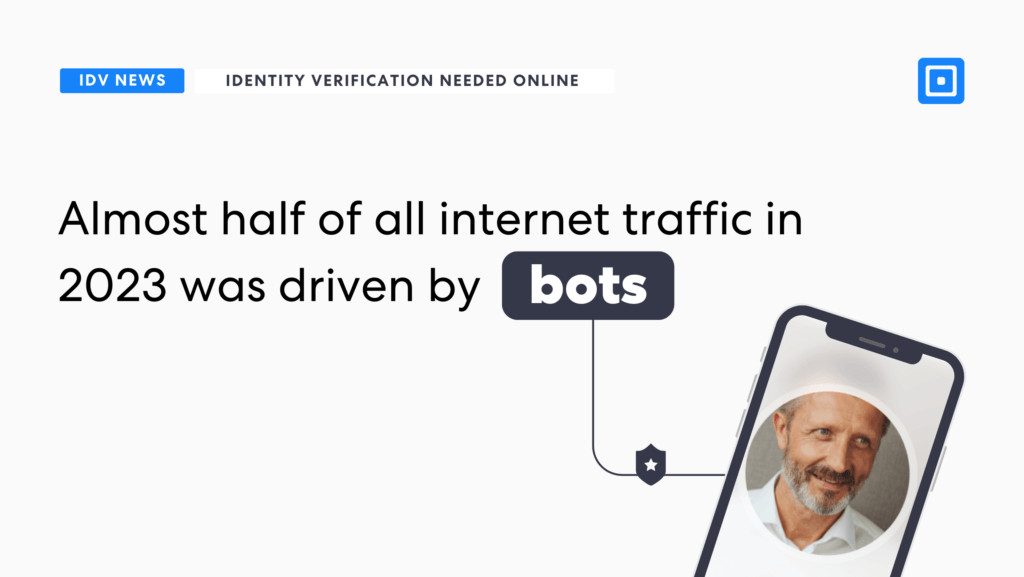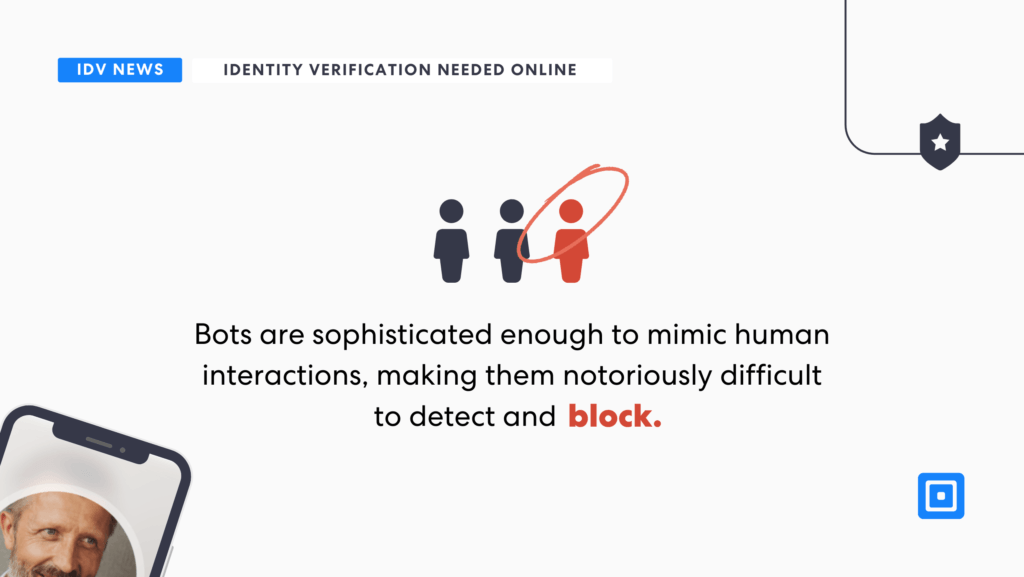Almost half of all internet traffic in 2023 was driven by bots. Despite interacting with bots on a daily basis, most people remain unaware of this startling fact. Our naivety is not due to ignorance but rather because modern bots can mimic human interactions with alarming accuracy. Undoubtedly, this makes bots extremely dangerous, as we’re left unable to distinguish authenticity from artifice. Without the necessary Know Your Customer (KYC) measures, we’re at risk of the content we consume being a product of artificial interference. Social media KYC needs to include Identity Verification (IDV) checks that leverage liveness detection technology and ID verification needed to detect fraudulent profiles before attacks occur.
Recent stats call for urgent action from online platforms. Users are currently vulnerable to fraudulent attacks on social media and dating sites, which, in 2023, resulted in losses averaging at £8,234 per victim. Bots are increasingly dominating the internet, and predictions suggest that they will soon carry out most internet traffic. Their influence not only results in online scams but also shapes society by tapping into political and socioeconomic events and rewriting critical narratives.
A Fight Between Bots
One example of this is a case that took place in early 2024, in which armies of bots fought on social media over the Chinese spy balloon incident. Researchers from Carnegie Mellon University examined 1.2 million tweets related to the incident, finding some interesting results. The Chinese tweets were mainly artificial, with 64% of the tweets written by bots. However, the US also used bots to try and shift the blame, with 35% of their tweets coming from bots.

This case points to the fact that many of the narratives we consume every day through online platforms such as Twitter or Facebook are not to be trusted. While no organization or entity is necessarily to blame for enabling the outcomes of bot-driven traffic, it seems that increased accountability may be necessary in order to address the lack of stringent user checks.
Platforms like Facebook are open about the number of accounts that they have to delete each quarter in order to stay on top of fraudulent accounts. It is certainly positive that Meta prioritizes removing these accounts and is transparent about doing so. However, perhaps the focus should shift to preventing these users from signing up for the platform in the first place.
In the fourth quarter of 2023, Facebook removed nearly 700 million fake social media accounts after removing 827 million in the previous quarter. Yet, no matter how many suspicious users are removed, more undoubtedly reappear. This heavily indicates that the issue lies with the sign-up process. On Instagram or Twitter, anyone can create a social media account very quickly without needing to verify their identity, putting all users at risk.
What Does This Mean For Fraud?
Most cases of fraud actually do start online, as social media platforms are a great place for fraudsters to hide behind a fake name and profile picture. For this reason, interactions on social media sites are often fraudulent, with several kinds of attacks, such as investment or romance scams, being carried out.
Almost 80% of scams start online, and we have long called for social media and tech companies to do more to protect their users.
A Lloyds spokesperson recently spoke to The Sunday Times, stating that “Almost 80% of scams start online, and we have long called for social media and tech companies to do more to protect their users and help refund innocent victims.” Lloyds and other banking groups understand the burden of these victims, as they’re often required to compensate victims for cases of online fraud. These losses are continually affecting the UK economy, whether it’s individuals or banks taking the hit, affecting national GDP.
Is It Too Late For Social Media KYC?
If social media platforms don’t change their stance on sign-up processes, we might soon find that bots control most of our social media feeds. While this will add some complexity to signing up, a positive user experience can still be maintained with the right AI-powered tools that can carry out IDV checks in a matter of seconds.
Automated bots will soon surpass the proportion of internet traffic coming from humans.
Nanhi Singh, GM of application security at Imperva, stated in a recent news piece that “Automated bots will soon surpass the proportion of internet traffic coming from humans, changing how organizations approach building and protecting their websites and applications. As more AI-enabled tools are introduced, bots will become omnipresent. Organizations must invest in bot management and API security tools to manage the threat from malicious, automated traffic.”

In light of this forecast, it’s critical that online platforms reconsider their priorities and implement sophisticated IDV infrastructure to protect users and safeguard their sites. With the new Labour government in the UK, they could also be vulnerable to having to reimburse fraud victims from October 2024. For more information on upcoming changes in the accountability of online fraud, read our piece on Labour Holding Big Tech Accountable.
Next Steps for Safer Sites
IDV software offers a sophisticated approach to mitigating bot-driven traffic on social media by enforcing stringent user authentication and IDV measures. These platforms can implement:
Document Checks: These checks verify that the presented identity is authentic and valid by examining official documents such as passports to confirm their legitimacy and unaltered.
Biometric Identity Checks: Biometric identity verification analyses subtle micro-expressions and ensures the identity document presented matches the user. It leverages liveness detection technology to determine whether the user is alive and physically present during the process.
Age Verification: Ensuring that users are not minors is also critical to maintaining the safety of these online sites. Age verification should be carried out to reduce the risk of children being subjected to any kind of online abuse.
By integrating these methods, IDV platforms can effectively reduce bot traffic and protect social media platforms from exploitation. These measures ensure that new accounts belong to real individuals, preventing bots from spreading spam or misinformation.
Social Media KYC Services
Robust IDV and eKYC infrastructure are more crucial than ever to effectively meet the challenges of increasing online fraud. Implementing advanced document verification, biometric checks, and liveness detection is needed to protect users from fraudulent attacks.
ComplyCube is renowned for its state-of-the-art identity verification (IDV) checks, leveraging advanced ISO 30107-3 and PAD Level 2-certified biometric liveness detection technology to check whether the person presenting the identity document is the same individual.

Contact their expert compliance team to learn more about protecting your online platform from fraud.



